Gumdrop Geometry: Doing Fun Science at Home during School Closures (Activity #15)
Follow along with a Science Buddies parent who is using family STEM activities to keep her kids learning at home during the COVID-19 school shutdown. New posts every Monday, Wednesday, and Friday. Today's adventure... building geodesic domes and other gumdrop geometry structures.
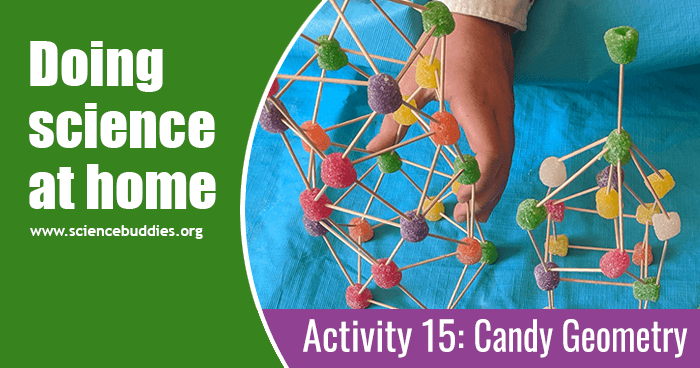
Geometric structures of varying sizes made from toothpicks and gumdrop candies
Math and Science Go Hand-in-Hand
From the beginning of our learn-from-home STEM adventure during school closures due to the COVID-19 pandemic, I planned to do activities from all STEM areas with my kids – science, technology, engineering, and math. The first couple of activities focused on science concepts. We added in engineering when we made our straw robot hands. With this activity, we've finally reached math.
My second grader was just starting her geometry unit when our schools closed. We've tried to continue that unit at home, but according to her, I'm "not a very good teacher." Umm... yeah, this is why I never dreamed I'd be homeschooling! Yet here we are.
While I may not be very good at teaching second-grade math, we're doing just fine with our fun science activities, so I got to thinking about how math and science are related to one another. Communication about science concepts and discoveries often relies heavily on math. Similarly, our understanding of math comes from experimentation and trying things out — which is the process of science. Simply put, math and science go hand-in-hand. Don't take my word for it though; prove it for yourself! Here are a few fun activities which involve both math and science:
- Circular Reasoning: Finding Pi: measuring and comparing circle circumferences and diameters helps kids see Pi in a concrete way.
- Puzzle Fun with a Perimeter Magic Triangle: you'll have a whole new appreciation for arithmetic after trying to get the numbers on each side of a triangle to add up in this puzzle.
- What Are the Chances?: experimenting with dice rolls and coin flips can give you an intuitive understanding of probability.
- Build a Gumdrop Geodesic Dome: both geometry and civil engineering are explored in this simple exploration of building a structure with toothpicks and gumdrops.
My Pick of the Day: Gumdrop Geometry
As I mentioned above, my second grader is learning about geometry. The goal right now is to learn the names of a subset of shapes like triangles, quadrilaterals, pentagons, etc., and the attributes of these shapes. We're both sick of the worksheets. I figured the only way to redeem myself from the label of being a not-good-teacher was to up the fun level and use the Build a Gumdrop Geodesic Dome activity as part of our approach to "learning geometry."
As usual, we started by watching the video:
My seventh-grader, who had been lured by the word "gumdrop," immediately recognized the activity as something he and I did several years back with his scouting troop. (Although, in that case we used the activity to talk about civil engineering, and I swapped gumdrops for grapes.)
Both kids were enthusiastic to give it a try and started out by following the directions to build a geodesic dome. Along the way, I asked my second-grader to name each shape she created (and count the number of sides) — after all, this was supposed to be our geometry lesson.
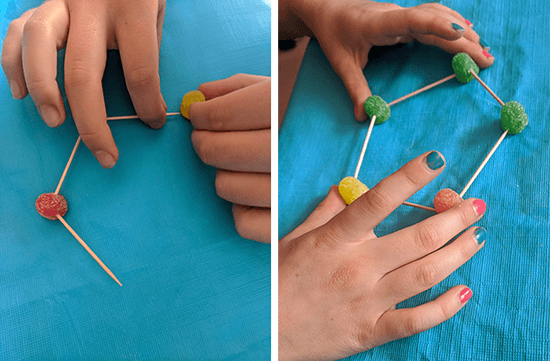
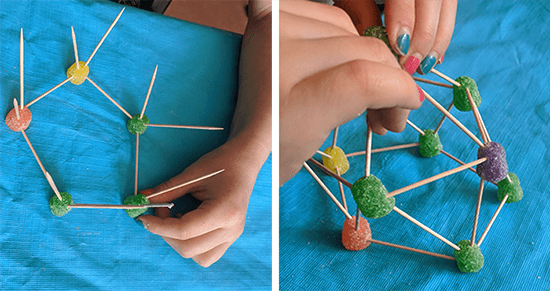
As advertised, the domes turned out to be pretty strong. My youngest wasn't sure if it was the strongest possible shape though, so she decided to compare it to a cube — which we quickly found to be flimsy in comparison.
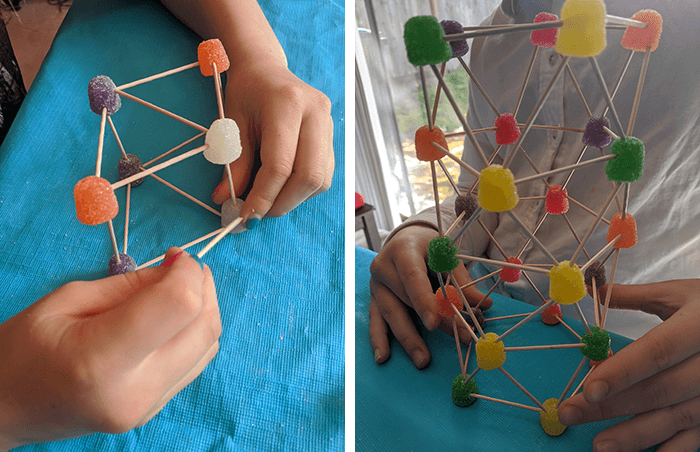
My son decided to modify his dome and keep adding additional layers of triangles eventually ending up with a cool shape that, after some debate and googling, we decided may be an elongated pentagonal bipyramid (or something like that).
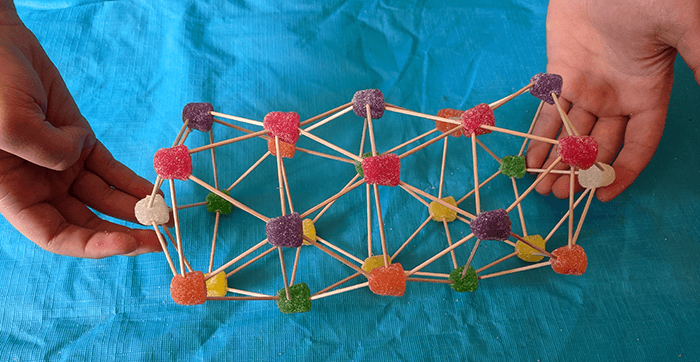
Meanwhile, my daughter went rogue building and comparing all sorts of structures — which was absolutely fine with me. Her house's roof turned out to be a triangular prism, so we even snuck in some new shape names to round out our learning.
We used up every last gumdrop and ended up with a number of cool structures, two proud builders, and one geometry-schooled second grader in just under forty minutes.
Geodesic domes are fun to explore and can be scaled up in size depending on the materials you use. For more inspiration about doing geodesic dome projects and or geometry using candies and toothpicks, see these posts: Making a Geodesic Dome from Straws, Candy Corn Geodesic Dome, and A Geodesic Dome for the Season.
If your kids make geodesic domes, or try any other of the math-related activities, post a picture of their experiment on social media and tag us. You can find us at Twitter, Facebook, and Instagram.
If this blog post was useful to you, please share it with other parents. Follow the links below to see what other science adventures we've been having at home.
View All Posts in this Series
- Activity 1 - Getting Started and Hand Washing
- Activity 2 - Taking Flight with Kites
- Activity 3 - Candle Seesaw and Fire Science
- Activity 4 - Dissecting Flowers
- Activity 5 - Building a Toy Parachute
- Activity 6 - Paper Marbling
- Activity 7 - Shaping Hard-boiled Eggs
- Activity 8 - Invisible Ink
- Activity 9 - Robot Hand
- Activity 10 - Plastic Egg Rockets
- Activity 11 - Rubber Band Guitar
- Activity 12 - Making Model Viruses
- Activity 13 - Air Cannons
- Activity 14 - Balancing an Art Mobile
- Activity 15 - Gumdrop Geometry
- Activity 16 - Solar Updraft Tower
- Activity 17 - Cotton Ball Launcher
- Activity 18 - Wire Water Striders
- Activity 19 - Ice Cream in a Bag
- Activity 20 - Wind-powered Sail Cars
- Activity 21 - Curling Metal
- Activity 22 - Popsicle Stick Catapult
- Activity 23 - Candy Diffusion
- Activity 24 - STEM Videos
- Activity 25 - Making Slime
- Activity 26 - Straw Siphon
- Activity 27 - Elephant Toothpaste
- Activity 28 - Balloon Hovercraft
- Activity 29 - Aluminum Foil Boats
- Activity 30 - Wall Marble Run
A science activity log is available as a Word document or as a Google doc for online convenience. (Just choose "File/Make a copy" to save it to your Google Drive.)
About the Author
Sandra, Science Buddies' Vice President of STEM education, holds a PhD in Genetics from Stanford University and has spent the last twelve years working on science education and STEM outreach. Right now, she's stuck working from her home in the Pacific Northwest with her husband, second grader, middle schooler, and two oddly noisy gerbils. She hypothesizes her sanity will hold as long as she gets a daily dose of sunshine.
Categories:
You Might Also Enjoy These Related Posts:
- Wall Marble Run: Doing Fun Science at Home during School Closures (Activity #30)
- Aluminum Foil Boats: Doing Fun Science at Home during School Closures (Activity #29)
- Hovercraft: Doing Fun Science at Home during School Closures (Activity #28)
- Elephant Toothpaste: Doing Fun Science at Home during School Closures (Activity #27)
- Straw Siphon: Doing Fun Science at Home during School Closures (Activity #26)
- Slime Three Ways: Doing Fun Science at Home during School Closures (Activity #25)
- A STEM Videos Breather: Doing Fun Science at Home during School Closures (Activity #24)
- Candy Experiments: Doing Fun Science at Home during School Closures (Activity #23)










